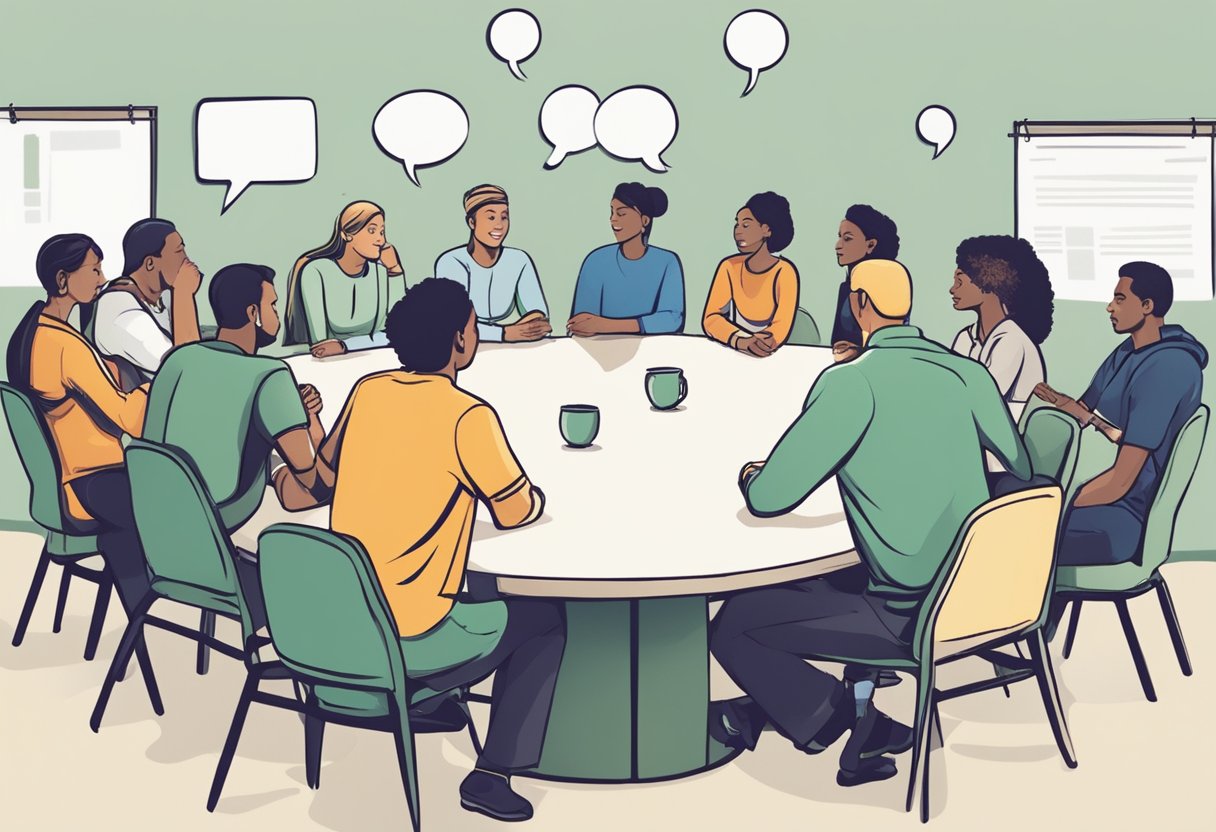Discover essential strategies for fostering clarity and trust with our guide on How to Improve Communication in an Open Relationship. Learn the keys to confident and effective dialogue today
Table of Contents
Introduction – Communication in an Open Relationship
In open relationships, communication is essential and differs somewhat from monogamous partnerships. Establishing a strong foundation of openness allows individuals to navigate the complexities of non-monogamy with a sense of security and clarity. Enhancing communication skills is crucial for those involved in an open relationship to ensure that all parties feel heard, respected, and valued. Insights from relationship experts suggest that articulating boundaries and expectations can facilitate a healthier dynamic where both intimacy and autonomy coexist.

Despite the unique challenges that may arise within open relationships, adopting effective communication techniques can foster deeper connections and minimize potential misunderstandings. It is about balancing expressing personal needs and being receptive to a partner’s perspective. Maintaining this exchange level requires ongoing effort and a willingness to adapt as the relationship evolves. Professional guidance can often help couples to refine their communicative approach and address questions that frequently emerge within the context of open relationships.
Key Takeaways
- Effective communication is key to the success of an open relationship.
- Communication techniques can be improved with practice and professional guidance.
- Maintaining connectivity and overcoming challenges are critical for relationship health.
Building the Foundation of Open Communication

Effective communication in open relationships requires a sturdy foundation, emphasizing the significance of honesty, the necessity for active listening, and the development of empathy. These components work synergistically to foster trust and understandings that are imperative for maintaining healthy and fulfilling connections.
Understanding the Role of Honesty and Openness
In an open relationship, honesty is not just a virtue; it’s the bedrock that ensures partners’ stability and safety. Openness allows individuals to share their desires, experiences, and boundaries without fear of judgment. According to a resource from Verywell Mind, effective communication minimizes negative rumination and promotes positive conflict resolution.
Recognizing the Importance of Active Listening
Active listening is a communication skill that requires full attention on the speaker, acknowledging their message, and responding thoughtfully. Positive Psychology illustrates that paying close attention to your partner without judgment encourages a deeper connection and exchange of ideas.
Cultivating Empathy Within the Relationship
Empathy involves understanding and sharing the feelings of another. Empathy helps partners validate each other’s experiences and emotions in an open relationship, thereby strengthening trust. A guide from Stiftelsen 29k Foundation emphasizes the importance of taking perspective and being understood as key components in effective communication.
| Key Findings | Relevant Entities |
|---|---|
| Honesty enhances conflict resolution and reduces negative feelings | Honest communication, trust |
| Active listening fosters deeper connections | Active listening, good communication |
| Empathy is crucial for emotional validation and trust building | Empathy, understanding |
By integrating honesty, active listening, and empathy into the dynamics of an open relationship, partners can build a stable and communicative environment conducive to personal growth and mutual satisfaction.
Exploring Communication Techniques

Effective communication in an open relationship relies on the harmonious blend of verbal and nonverbal cues alongside a structured feedback mechanism to foster understanding and connection.
The Significance of Nonverbal Cues
Nonverbal communication, particularly body language and eye contact, is pivotal in conveying emotions and intentions without words. For instance, consistent eye contact can signal attentiveness and trust, while an open posture can indicate a willingness to engage and connect. Research suggests that nonverbal cues can carry over half of a conversation’s emotional meaning.
| Technique | Description | Importance |
|---|---|---|
| Body Language | The use of physical behavior to express feelings | Conveys unspoken emotions and attitudes |
| Eye Contact | Maintaining visual connection to show engagement and sincerity | Builds trust and shows attentiveness |
Enhancing Verbal Communication
Verbal communication is about the clear conveyance of a message through words. It’s vital to share desires, expectations, and boundaries in an open relationship. Tactics like using “I” statements can reduce defensiveness and clarify personal feelings without placing blame or creating conflict.
| Keyword | Entity |
|---|---|
| Verbal Communication | Sharing desires and boundaries |
| “I” Statements | Reducing potential conflict |
The Art of Giving and Receiving Feedback
Feedback in an open relationship should be a reciprocal exchange—offering and accepting constructive comments geared towards improving the relationship dynamic. Acknowledging the energy behind the feedback and responding with sensitivity is crucial. This exchange helps partners understand each other’s perspectives and facilitates growth in the relationship.
| Type | Application in Open Relationships | Relevance |
|---|---|---|
| Giving Feedback | Offering constructive insight into behaviors and needs | Facilitates growth |
| Receiving Feedback | Accepting and understanding a partner’s perspective | Promotes mutual understanding |
Navigating Challenges in Communication

Effective communication in an open relationship requires a nuanced understanding of interpersonal dynamics, actively addressing conflict and disagreements, managing criticism and blame, and considering how past experiences influence current interactions.
Addressing Conflict and Disagreements
When conflict and disagreements arise, it’s essential to approach each other with a mindset geared towards resolution. Prioritizing fact over perspective helps to maintain clarity. For instance, setting ground rules for discussions can prevent resentment and fear from escalating. An effective method is using “I” statements to express thoughts and feelings without casting blame.
Managing Criticism and Blame
Navigating criticism requires separating fact from emotion, allowing individuals to discuss issues without personal attacks. A technique to mitigate blame is to focus on behavior and situations, rather than ego or character. This shifts the conversation from accusatory to constructive, as highlighted in an article on Verywell Mind about the positive effects of healthy communication.
The Influence of Past Experiences on Present Conversations
Past experiences often shape fear and perspective, clouding present conversations with resentment or preconceived notions. Acknowledging these influences is the first step to overcoming them. A piece on Psych Central offers strategies such as letting go of blame to foster better communication.
| Key Concepts | Relevant Information | Source URL |
|---|---|---|
| Conflict Resolution | Using “I” statements to express feelings | https://www.verywellmind.com/managing-conflict-in-relationships-communication-tips-3144967 |
| Criticism Management | Focusing on behavior, not character, to stay constructive | https://www.verywellmind.com/managing-conflict-in-relationships-communication-tips-3144967 |
| Past Influences | Recognition and understanding of past influences on communication | https://psychcentral.com/blog/cultivating-contentment/2020/07/22-steps-to-better-communication-in-your-relationships |
| Entity | Usage |
|---|---|
| Conflict | Bold |
| Disagreements | Italic |
| Criticism | Italic |
| Blame | Bold |
| Fact | Italic |
| Perspective | Italic |
| Resentment | Italic |
| Fear | Italic |
| Ego | Bold |
Maintaining Connection and Intimacy

In open relationships, balancing the delicate interplay between connection and personal space is essential for maintaining fulfilling intimacy and relationship satisfaction. This balance requires clear, empathetic communication and a deep understanding of each partner’s emotional needs.
The Balance Between Affection and Personal Space
Open relationships thrive when partners strike the right balance between affection and maintaining personal space. Affection helps maintain a sense of closeness, but individuals also need personal space to pursue independent interests and maintain their sense of self.
| Key Concept | Explanation | Source URL |
|---|---|---|
| Affection vs. Personal Space | Nurturing warmth while respecting boundaries promotes harmony. | verywellmind.com |
Fostering a Deep Emotional Connection
For partners to form a deep emotional connection, they must engage in reciprocal self-disclosure. This involves sharing experiences, beliefs, values, opinions, and expectations. Through mutual vulnerability, partners can foster intimacy beyond the surface level.
| Key Concept | Explanation | Source URL |
|---|---|---|
| Deep Emotional Connection | Mutual sharing builds intimacy and trust. | positivepsychology.com |
Ensuring Relationship Satisfaction Through Communication
Clear, empathetic communication is the cornerstone of ensuring relationship satisfaction. By expressing needs and listening actively, partners can work together to create a fulfilling dynamic that meets the emotional requirements of all involved in the relationship.
| Finding | Relationship Aspect | Source URL |
|---|---|---|
| Empathetic Communication | Key to understanding and validating feelings. | gottman.com |
Each subsection above contains crucial elements for maintaining both connection and intimacy in open relationships. Affection must be balanced with respect for personal space, deep emotional connections require openness, and relationship satisfaction is fortified through empathetic communication—these are the pillars upon which strong, fulfilled romantic and intimate relationships are built.
Professional Perspectives on Communication

In the realm of open relationships, clear and consistent communication is vital. Professionals underscore its importance to prevent misunderstandings and foster a secure environment for all parties involved.
Insights From Relationship Experts
Experts in relationship dynamics, such as Dr. John Gottman, emphasize the value of healthy communication. Gottman identifies specific communication styles that can predict the success or failure of a relationship. These styles, called the “Four Horsemen” by Gottman, spotlight destructive behaviors which are contrasted by their positive counterparts, focusing on therapy and couples counseling to teach partners how to communicate effectively.
| Key Concept | Related Information |
|---|---|
| Gottman’s Four Horsemen | Criticism, Defensiveness, Stonewalling, and Contempt |
| Healthy Counterparts | Gentle Start-Up, Taking Responsibility, Self-Soothing, and Building a Culture of Appreciation |
| Role of Therapy | To instill positive communication styles and manage conflict |
Insights provided by Dr. John Gottman
The Role of Therapy in Enhancing Communication
Within the domain of open relationships, encounters with family therapy and couples therapy can be instrumental. These forms of therapy teach communication skills that help everyone express their needs and concerns without hostility or fear of judgment. Therapists act as mediators, facilitating the exploration of new ways of healthy communication. They typically introduce structured exercises designed to improve listening skills and empathetic understanding between partners.
| Focus of Therapy | Description |
|---|---|
| Communication Exercises | Active listening and expressiveness activities |
| Constructive Feedback | Methods for sharing feelings constructively |
| Emphatic Understanding | Techniques to foster empathy and comprehension |
Therapy’s Role in Communication
Frequently Asked Questions
Effective communication in an open relationship requires understanding and implementing strategies catering to non-monogamy’s unique dynamics. All parties must maintain an open dialogue, manage emotions constructively, and actively listen to each other’s concerns.
What are effective strategies for enhancing communication in a non-monogamous partnership?
In open relationships, establishing clear boundaries and discussing expectations are foundational strategies. Consistent check-ins can help partners stay aligned on their boundaries and comfort levels. To learn more about enhancing communication, see Importance + How to Improve It.
What techniques can be employed to discuss feelings without conflict in an open relationship?
When discussing feelings, it is important to use “I” statements to express oneself without blame and to practice empathetic listening. This approach allows individuals to share openly and builds a sense of security within the relationship. More on this can be read at Questions Couples Can Ask To Improve Communication.
In what ways can partners increase transparency and foster better dialogue?
Transparency can be increased by sharing intentions with each other and offering reassurances when needed. Using honesty and vulnerability in conversations helps in fostering better dialogue and trust. An excellent resource on this topic is available here.
How can one address and improve lapses in communication within an open relationship?
Addressing lapses in communication can be done by acknowledging the issue directly and scheduling a dedicated time to discuss the concerns. These moments allow for reflection and mutual understanding, essential for improvement. Further information can be found at 22 Steps To Better Communication In Your Relationships.
What role does active listening play in strengthening communication between open relationship partners?
Active listening, which involves fully concentrating and understanding your partner’s perspective, is critical in open relationships. It ensures that each partner feels heard and respected, thus strengthening their connection. Insightful details on this topic are presented here.
Can you suggest any exercises or activities that promote better communication for individuals in open relationships?
Exercises such as relationship check-ins and empathy-building activities can promote better communication. Examples include regular discussions about personal growth, feelings, and how each partner’s relationship dynamics work. For practical exercises, visit How to improve communication.




